Ontogeny of odor-LiCl vs. odor-shock learning: similar behaviors but divergent ages of functional amygdala emergence
- PMID: 19181617
- PMCID: PMC2661245
- DOI: 10.1101/lm.977909
Ontogeny of odor-LiCl vs. odor-shock learning: similar behaviors but divergent ages of functional amygdala emergence
Abstract
Both odor-preference and odor-aversion learning occur in perinatal pups before the maturation of brain structures that support this learning in adults. To characterize the development of odor learning, we compared three learning paradigms: (1) odor-LiCl (0.3M; 1% body weight, ip) and (2) odor-1.2-mA shock (hindlimb, 1 sec)--both of which consistently produce odor-aversion learning throughout life and (3) odor-0.5-mA shock, which produces an odor preference in early life but an odor avoidance as pups mature. Pups were trained at postnatal day (PN) 7-8, 12-13, or 23-24, using odor-LiCl and two odor-shock conditioning paradigms of odor-0.5-mA shock and odor-1.2-mA shock. Here we show that in the youngest pups (PN7-8), odor-preference learning was associated with activity in the anterior piriform (olfactory) cortex, while odor-aversion learning was associated with activity in the posterior piriform cortex. At PN12-13, when all conditioning paradigms produced an odor aversion, the odor-0.5-mA shock, odor-1.2-mA shock, and odor-LiCl all continued producing learning-associated changes in the posterior piriform cortex. However, only odor-0.5-mA shock induced learning-associated changes within the basolateral amygdala. At weaning (PN23-24), all learning paradigms produced learning-associated changes in the posterior piriform cortex and basolateral amygdala complex. These results suggest at least two basic principles of the development of the neurobiology of learning: (1) Learning that appears similar throughout development can be supported by neural systems showing very robust developmental changes, and (2) the emergence of amygdala function depends on the learning protocol and reinforcement condition being assessed.
Figures

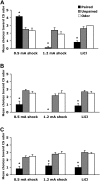
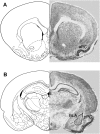
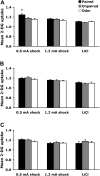
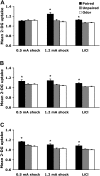
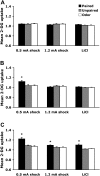
Similar articles
-
Rodent model of infant attachment learning and stress.Dev Psychobiol. 2010 Nov;52(7):651-60. doi: 10.1002/dev.20482. Dev Psychobiol. 2010. PMID: 20730787 Free PMC article. Review.
-
Development switch in neural circuitry underlying odor-malaise learning.Learn Mem. 2006 Nov-Dec;13(6):801-8. doi: 10.1101/lm.316006. Epub 2006 Nov 13. Learn Mem. 2006. PMID: 17101877 Free PMC article.
-
Dual circuitry for odor-shock conditioning during infancy: corticosterone switches between fear and attraction via amygdala.J Neurosci. 2006 Jun 21;26(25):6737-48. doi: 10.1523/JNEUROSCI.0499-06.2006. J Neurosci. 2006. PMID: 16793881 Free PMC article.
-
Adult depression-like behavior, amygdala and olfactory cortex functions are restored by odor previously paired with shock during infant's sensitive period attachment learning.Dev Cogn Neurosci. 2011 Jan;1(1):77-87. doi: 10.1016/j.dcn.2010.07.005. Dev Cogn Neurosci. 2011. PMID: 21037982 Free PMC article.
-
The development and neurobiology of infant attachment and fear.Dev Neurosci. 2012;34(2-3):101-14. doi: 10.1159/000336732. Epub 2012 May 8. Dev Neurosci. 2012. PMID: 22571921 Free PMC article. Review.
Cited by
-
Ontogeny of classical and operant learning behaviors in zebrafish.Learn Mem. 2012 Mar 20;19(4):170-7. doi: 10.1101/lm.025668.112. Learn Mem. 2012. PMID: 22434824 Free PMC article.
-
Social Regulation of Negative Valence Systems During Development.Front Syst Neurosci. 2022 Jan 20;15:828685. doi: 10.3389/fnsys.2021.828685. eCollection 2021. Front Syst Neurosci. 2022. PMID: 35126064 Free PMC article. Review.
-
Neurobiology of Infant Fear and Anxiety: Impacts of Delayed Amygdala Development and Attachment Figure Quality.Biol Psychiatry. 2021 Apr 1;89(7):641-650. doi: 10.1016/j.biopsych.2020.08.020. Epub 2020 Aug 30. Biol Psychiatry. 2021. PMID: 33109337 Free PMC article. Review.
-
Functional emergence of the hippocampus in context fear learning in infant rats.Hippocampus. 2010 Sep;20(9):1037-46. doi: 10.1002/hipo.20702. Hippocampus. 2010. PMID: 19739248 Free PMC article.
-
Rodent model of infant attachment learning and stress.Dev Psychobiol. 2010 Nov;52(7):651-60. doi: 10.1002/dev.20482. Dev Psychobiol. 2010. PMID: 20730787 Free PMC article. Review.
References
-
- Alleva E., Calamandrei G. Odor-aversion leaning and retention span in neonatal mouse pups. Behav. Neural Biol. 1986;46:348–357. - PubMed
-
- Bahar A., Dorfman N., Dudai Y. Amygdala circuits required for either consolidation or extinction of taste aversion memory are not required for reconsolidation. Eur. J. Neurosci. 2004;19:1115–1118. - PubMed
-
- Barkai E., Saar D. Cellular correlates of olfactory learning in the rat piriform cortex. Rev. Neurosci. 2001;12:111–120. - PubMed
-
- Batsell W.R., Best M.R. Variations in the retention interval of taste aversions: Evidence for retrieval competition. Anim. Learn. Behav. 1992;20:146–159.
-
- Batsell W.R., Best M.R. One bottle too many? Method of testing determines the detection of overshadowing and retention of taste aversions. Learn. Behav. 1993;21:154–158.
Publication types
MeSH terms
Substances
Grants and funding
LinkOut - more resources
Full Text Sources
Medical
